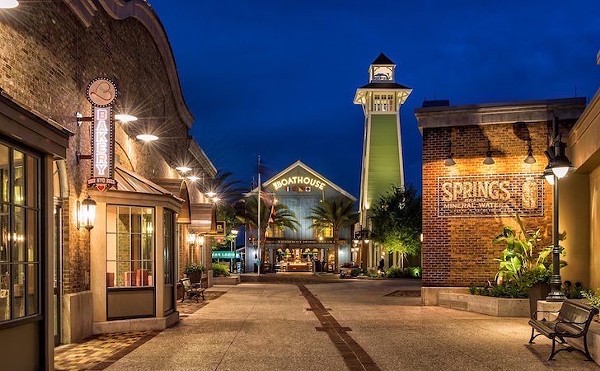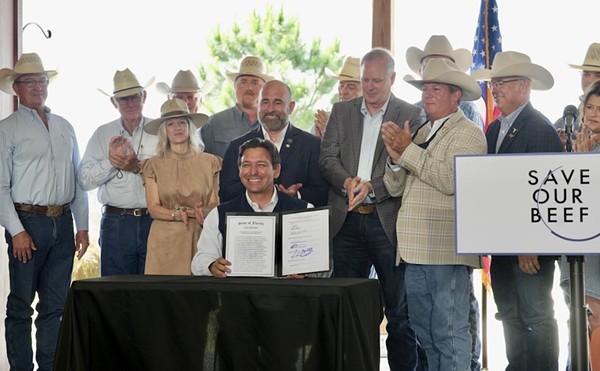It is a gloomy Friday afternoon on the section of highway where I-4 meets the East-West Expressway. Gloomy because gray clouds hang low over the city, and gloomy because the roadway is so congested with traffic we are reduced to a stop-and-go putter. Traffic estimates from Metroplan Orlando for this particular stretch of roadway say that 11,000 cars will pass this intersection in the next hour, making it the most congested spot in the Orlando metropolitan area on any given weekday afternoon. Today all 11,000 cars seem to have arrived at once, creating a logjam anyone who drives I-4 will recognize.
Cars speed up, slow down, speed up, slow down, -- SUVs, VW Jettas, work vans, charter buses, motorcycle cops in rain gear, beat-up jalopies, etc. It makes me drowsy; more so when I see a baby asleep in the back seat of a car loaded with luggage.
Except for the drivers, most of the cars in this polluted river of traffic are empty. American car trips aren't very efficient, averaging just 1.6 passengers per run, driver included. That figure varies from location to location, of course. In downtown Orlando, cars average about one person per trip; near the theme parks, where tourists command the highways, the figure is closer to two passengers per trip.
Many of those drivers in otherwise empty cars could be in here with me, on a LYNX bus. This particular model is a Galaxy diesel, featuring plush seats and ice-cold air conditioning. It's roomy enough to seat maybe 40 people. On this trip, from downtown to International Drive, only six people decided to join me, including a bald-headed guy stretched across the back seats, asleep.
These few passengers are headed to shift work in the I-Drive area. Every day there are similar pilgrimages as employees of SeaWorld, Burger King, Wendy's and other corporations that thrive on minimum wage, service-sector jobs wait in the downtown transit station. According to LYNX's own stats, more than 70 percent of LYNX riders use the bus to get to work. Most of them, 75 percent, live in Orange County. Sixty percent are younger than 34. Fifty-eight percent are Hispanic or black. They don't make much -- on average only $350 a week before taxes. Almost half have worked their jobs less than a year. The typical LYNX rider is a young black female who works as a fast-food cashier.
The last resort
In other words, the typical LYNX rider is not me, a white male over 30 earning more than minimum wage.
Years ago, when I was in high school in New Orleans, I rode public transit. I lived in the suburbs and my school was in the Garden District. So I hopped a streetcar, which ran about every 10 minutes along St. Charles Avenue. Then I had to transfer to an old, loud, rickety bus that ran an irregular schedule and sounded as if it would fall apart when it went over train tracks. I hated the bus. I wasn't alone then, and I'm not alone now.
It is almost a rite of passage to forget public transit ever existed once you make the middle class. The bus becomes the choice of last resort. There are many reasons why: our affinity for and reliance on the automobile, an association between minorities and public transportation, and a feeling that the system is too hard to figure out.
Still, more people than you'd imagine have at least thought about hopping a bus. A 2002 study by the Center for Urban Transportation Research at the University of South Florida found that 34 percent of non-bus riders said they "seriously considered" riding LYNX, but didn't do it.
That may change as gas prices rise. A 1982 study of Wisconsin drivers found 60 percent would consider alternative transportation if gas cost between $2.50 and $3. That would save a lot of car trips; in Orange County alone there were 784,335 licensed drivers in 2001, up 16 percent from the previous year. Cars in the three-county region (Orange, Osceola and Seminole) put almost 40,000 tons of nitrogen oxide and volatile organic compounds -- the precursors to smog -- into the air annually, according to a study by UCF engineering professor C. David Cooper. In 20 years, the figure will be closer to 60,000 tons, even though automakers have reduced polluting emissions from 12 grams per mile, per car, in the 1970s, to two grams per mile today.
Yet the one governmental agency that could lure drivers out of their cars as gas prices soar can't seem to capitalize on the opportunity.
For the past few years, LYNX managers have fought off one public-relations disaster after another. The latest was last fall when a television station followed LYNX board members and employees to Las Vegas and videotaped them gambling and drinking when they should have been at seminars. It didn't help that immediately after the segment aired, LYNX announced it was $1 million over budget and had used all of the $2.4 million in its reserve fund. Executive Director Byron Brooks and two senior managers resigned, but the damage was done, especially since five board members caught on tape have remained with the agency.
Naturally, some riders associate the Vegas trip with LYNX's decision to increase fares by a quarter in January. (A ride now costs $1.25.) As a female rider explained to me, the hike was needed to offset the fraud, waste and abuse shown on television.
Emergency brake
Our bus exits I-4 via a winding overpass onto State Road 528. Traffic tempo has picked up slightly, and cars accelerate to get in front of our slow-moving vehicle. On the opposite side of I-4, cars are lined up on an entrance ramp as far as the eye can see. It's going to be another long, stifling commute home for thousands of drivers.
Much of this area south of the city proper was undeveloped 30 years ago, about the time Disney came to town. Today, office and commercial development has filled the I-4 corridor, from Lake Mary past the theme parks, creating a 30-mile central business district along Central Florida's main corridor. The long, narrow growth is different than what takes place in older cities, where a single business-cultural hub expands in outward rings, like the trunk of a tree.
As development stretched along the interstate and away from downtown, the city's private transportation company, Orlando Transit Company, could no longer turn a profit. It folded in 1972. The same year, the Florida Legislature founded the Orange-Seminole-Osceola Transportation Authority, forming one of the few transit agencies in the nation to service three counties.
From the beginning it was apparent the Legislature made a big mistake. It failed to provide the agency with a funding source -- money from a sales tax, for example -- or governmental powers such as eminent domain to condemn property for public use. The organization's board of directors was divided between the three counties, even though Orange County was becoming increasingly urbanized while Seminole and Osceola were largely rural. Seminole commissioners blocked attempts to reorganize the board and hire an executive director, while Osceola commissioners simply refused to fund bus service in the misguided belief that buses should pay for themselves. For 20 years, the Tri-County Transit system only ran bus service in two counties; Osceola didn't get its first route until 1990.
The Seminole-Osceola block of the transit voting board angered Orange County and Orlando officials, who have been trying to build a light-rail transit system since the early 1980s. "I don't mind them screwing up their own transportation," former Orlando mayor Bill Frederick fumed in a 1983 Orlando Sentinel article. "But it's like they have gotten into our car, locked the door, put on the emergency brake, and said Ã?ha ha.'" Frederick wanted to merge the bus authority with a planning organization and the expressway authority to form one giant superagency, but the idea never materialized.
It wasn't until the early 1990s that the agency finally got serious. Jacob Stuart, now the head of the Orlando-area Chamber of Commerce, took over as chairman of the transit board, bringing a salesman's approach to public transportation. He painted the downtown bus station Pepto-Bismol pink and sent a pink bus on random routes around the city, offering free rides. He hosted a naming contest, giving Orlando grandmother Frances Morrison a free trip to the Bahamas for submitting the "LYNX" name.
Stuart hired the agency's first director, Paul Skoutelas, from a Pennsylvania transit authority, and reorganized LYNX's board of directors even though that put him out of a job. "We are no longer a joke," Frederick declared. By 1994, LYNX was busing a million riders a month and had become the fastest-growing transit company in America. Two years later, the agency won the first of three prestigious awards given by the American Public Transit Association, the organization that hosted the Vegas event last fall.
Today, LYNX covers more square miles -- 2,538 -- than almost any other transit agency in the country. (The Los Angeles County transit agency covers a relatively modest 1,423 square miles.) It has an $86 million budget, of which $49 million is paid by Orange County, Orlando, federal and state money. (Fares account for $20 million.) The money pays for 62 routes in five counties (including small parts of Volusia and Polk), 539 bus operators, 236 buses and approximately 7,200 gallons of diesel fuel daily. About 25.5 million riders get on the bus each year.
The agency compares favorably with others in the mid-sized category: Broward County, Phoenix, Ariz., Tacoma, Wash., Cincinnati and Austin, Texas. But the one thing those agencies have that LYNX lacks is a dedicated funding source. In 1999, Broward county commissioners earmarked a penny of its gas tax specifically for public transit. The dedicated source allowed Broward to expand its bus service. "We were able to build services based on that money," says Phyllis Berry, a Broward transit spokeswoman.
They run funny
LYNX riders generally have a good impression of the agency. A July survey, conducted by transit employees, found that almost 90 percent of riders are "somewhat satisfied" with timeliness and cleanliness of the buses, courtesy of drivers and convenience of the bus stops. The one drawback: frequency of bus trips, which scored below 80 percent.
A woman I spoke with at the Washington Shores Super Stop, one of six large transfer stations in the LYNX system, said weekends, especially Sundays, are the worst days to catch the bus. "They run funny," she said. "If you miss your bus, you have to wait, wait, wait."
Of course LYNX gets stuck in the same traffic as everyone else. It is difficult for LYNX to keep its buses on time when a single breakdown on I-4 can cause hour-long delays.
To help solve the problem, the U.S. Department of Transportation gave LYNX $3 million to study a Bus Rapid Transit system. Bus Rapid Transit is like a faster version of the downtown Lymmo system, which is a (free) ride around downtown in dedicated bus lanes. Buses are given traffic-signal priority and have limited stops in an attempt to speed things up. The most logical place to have a Bus Rapid Transit system is along I-4, in high-occupancy vehicle lanes. Of course there is no high-occupancy lane on I-4. According to Florida Department of Transportation spokesman Steve Homan, I-4 will never have high occupancy vehicle lanes because they are unenforceable. The DOT does have plans to build express lanes, which limit the number of exits drivers are able to use. But those plans are part of a larger $3 billion build-out of I-4, from the Osceola to Volusia county lines, that has not been funded.
Light rail could be even further behind. In the early 1980s, mayor Frederick worked feverishly to bring light rail to Orlando. The Sentinel even went so far as to print pictures of the kinds of trains people might see -- a monorail, light rail or automated train. But Frederick failed to land a system in part because Tri-County Transit had no executive director, one of the criteria the feds looked at when determining who should be awarded U.S. transportation money.
Four years ago, LYNX lost a lot of clout when it failed in a similar effort to bring a $600 million light-rail system to Central Florida. City and county officials expected to sign off on the deal said they either weren't getting timely information, or were getting bad information. Former Orlando council member Don Ammerman, who favored light rail, bailed out when he discovered ridership estimates looked like guesswork.
LYNX's tarnished reputation doesn't end there. Like the Orange County School Board, it relies too heavily on consultants. In the mid-1980s, the agency used a consultant to run day-to-day operations, which led to such conflicts as the employment of a temporary director, David Valtman, who also worked for the consulting company. In 1998, board members paid a consultant $2,000 to review the executive director's job performance instead of doing the evaluation themselves. They also paid a consultant $8,000 a month to accomplish tasks the executive director, Leo Auger, was paid an annual salary of $139,000 to perform.
LYNX also has a history of problems with the portion of its service that serves the disabled. The most recent evidence of that was a deal signed last year that caused a $600,000 cost overrun each month. The problem was LYNX's contract was based on a per-hour basis, not on a per-trip basis. So van contractors had no incentive to hustle to pick up passengers; they were paid to move slowly.
LYNX re-negotiated the deal three weeks ago, but not without causing a lot of anxiety. Congresswoman Corrine Brown sent a representative to the LYNX meeting, complaining that the entire contract should be re-bid.
Missteps like this are the reason LYNX officials will have trouble finding money for their projects. The agency's acting director, Howard Tipton Sr., got permission from board members to ask Orlando and Orange County commissioners for $3 million so the agency can build a new maintenance facility on 24 acres LYNX owns on John Young Parkway. Maintenance is currently done in two facilities, at a former elementary school on South Street and a former Volvo dealership on Princeton Avenue. Both facilities are operating beyond capacity.
But when Tipton travels to the commissions, he won't be welcomed with open pocketbooks. Some of the commissioners say they will take a long look at LYNX's board before agreeing to fund more projects. "Accountability," says Orange County commissioner Linda Stewart. "That's the first thing that comes to mind. It's not been there so far. It is very, very difficult to let loose with public money when you don't have a lot of faith in how it is used."
The funding backlash against LYNX has already begun. Orlando freshman commissioner Phil Diamond voted against approving $3.7 million toward the LYNX budget, in part because of the Vegas trip, and in part because he wants LYNX to provide more information for riders at bus stops. "I'd like to see them do a better job of marketing their transit sites," Diamond says. "I'd like to see them put a sign on a pole that gives riders basic information. When does the bus come by? Where does it go? How much does it cost? Do they make change? All the things potential riders want to know."
Passing gas
Our bus pulls onto I-Drive at 4 p.m., but the street isn't bottlenecked with traffic. It turns out to be a typical weekday afternoon. A guy in a Rosen Plaza Hotel uniform gets on board. In front of the Convention Center, our bus waits while a group of tourists trot across the crosswalk. At Sand Lake Road, our driver hits the horn and swerves over so a couple of our passengers can run to the bus ahead. Some of their passengers climb on board our bus.
I've seen these acts of charity each day I've ridden the bus -- little things that occur in the transit community you'd be hard-pressed to find in the me-first car culture. I've seen passengers carry baby carriages on board for strangers. I've seen them hand spare change to strangers who were a little short of bus fare. I've seen drivers allow passengers on who were 10 cents short of the full fare. I've seen young men give up their seats, or hold the back door open for passengers. I've seen bus drivers warn people about crossing lanes of traffic. I saw one of them wait as three girls and their father ran across a K-Mart parking lot to catch the bus.
The negatives? The only incident I saw was a couple of kids making fun of a pal who had passed gas on the bus.
Even so, the images of LYNX board members and employees gambling in Vegas lingers. No fewer than four state legislators have authored bills revamping LYNX in one way or another in part because of the Vegas incident.
What actually happened in Sin City? Not much.
An internal review of the newscast footage completed by LYNX attorney Tommy Boroughs and board secretary Bill Bagley found that of the 21 LYNX employees who attended the conference, only two were gambling during conference hours, and only one was drinking. One of the gamblers was Brenda Carey, a Jeb Bush appointee to the LYNX board. She was shown gambling at 11:45 a.m. on a Tuesday. But LYNX says the seminar she attended, "The Board Member as a Resource," concluded at 11:15 a.m. She was gambling on her lunch hour.
On another occasion, Carey was videotaped gambling when she should have been in "Monorails: They Aren't Just for Disney Any More." Carey said she missed most of the seminar because she was late from a previous session. She said she made arrangements to speak with monorail experts after the session concluded.
The other gambler was Robert Gaye, another Bush appointee to the LYNX board whose private transportation agency ran into legal trouble at the Orlando International Airport for failing to pay $292,637 in franchise fees. According to the LYNX audit, Gaye's actions in Vegas "were not appropriate as a LYNX board member on a LYNX funded trip."
LYNX board members also ate dinner, on five separate occasions, on the tab of companies that do business with the transit agency. The dinners ranged from $43 to over $100. It is not against ethics laws for employees or board members to accept gifts so long as they report any amount over $100, which LYNX officials did. The LYNX audit, backed by a state Ethics Commission investigation, found that board members and employees had violated no laws by accepting the meals.
So what the Vegas report boils down to is an ethically challenged LYNX board member gambling on company time, and another who was fortunate enough to explain away her actions. The question is, would the story have played as well if LYNX employees had cut industry seminars in Omaha, say, and hung out at a local coffee shop? Not likely.
Even so, the fallout from the Vegas trip might have been a blessing in disguise. It forced lawmakers to re-examine the structure of LYNX. Now, each time LYNX needs money for a new project, it must go "hat in hand" to local governments to ask for donations, as LYNX chairman Russ Hauck puts it. Not only does that inhibit LYNX from making long-range plans, it gives the appearance to city and county commissioners that LYNX is operating piecemeal.
"A dedicated funding source would get them off our backs politically," Hauck says.
State Rep. Randy Johnson and Sen. Lee Constantine have authored bills that would create the kind of superagency Bill Frederick wanted 20 years ago. It would bring LYNX, Metroplan Orlando and the Orlando-Orange County Expressway Authority under one umbrella organization.
But some local officials, such as Orlando mayoral candidate Wayne Rich, the former chair of the Expressway Authority, are against the plan, saying the three agencies have different purposes.
Another law, authored by Rep. David Simmons, is an amalgamation of other legislator bills. Simmons would reduce the size of the LYNX board, change its makeup so only local government officials are agency directors, and provide a referendum so voters can decide whether LYNX should become a taxing authority in the same manner as the library and school systems. Simmons goes one step further: A provision in his bill requires local governments that refuse LYNX's light-rail plan to draft an alternative, which LYNX would then incorporate into a light-rail master plan.
Unlike Rep. Randy Johnson's bill, Simmons' legislation would not dissolve LYNX and merge it with other agencies. "Why create another bureaucracy when we can focus on what LYNX is doing right," Simmons says.
Will anti-tax advocates seize on what LYNX did wrong in Vegas to thwart the agency's effort to find a funding source? Probably. After all, LYNX needs victories in three counties to get its own source of money.
Smooth sailing
Our bus has completed the trip down I-Drive and merges back onto I-4. Traffic is moving smoothly but I expect it will bottleneck as we get closer to downtown. The bus is quiet except for a guy listening to hip-hop music through his headphones. Every once in a while he sings "yeah, yeah" as he nods his head.
We pass the Mall at Millenia and still traffic is moving steadily, though on the west-bound side, cars are stacking up behind each other, including a purple LYNX bus. We begin to slow down near the Orange Blossom Trail exit, and I think this must be it. This is the point where traffic is so bad it will be an hour before we get back downtown.
Instead, the driver picks up speed and we cruise past construction workers busy on the inside lanes of I-4. Where the thousands of gridlocked cars have gone, I don't know. I'm sure they'll be back.
















